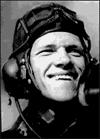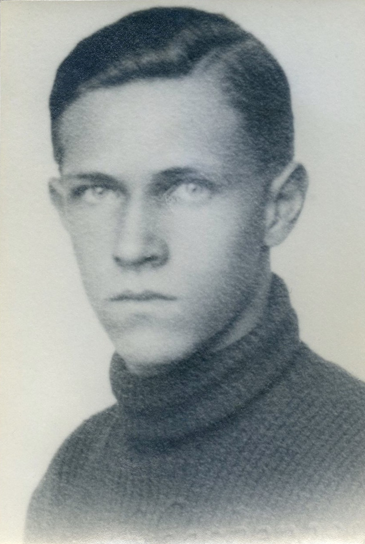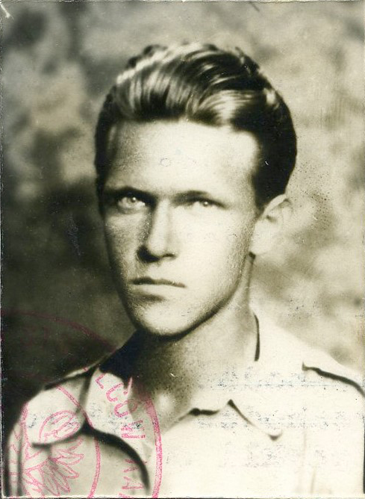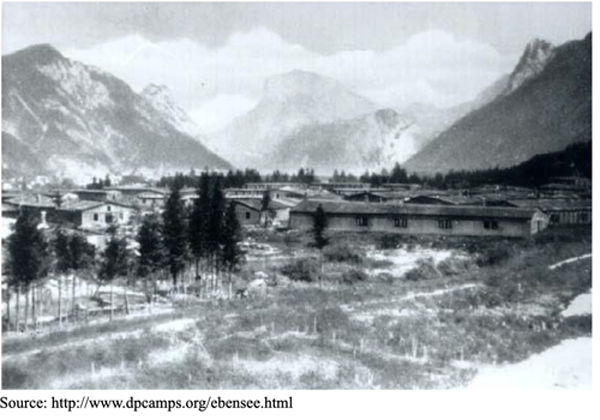





















|
|

ZENON WACLAW KRZEPTOWSKI (Kaye)
303 Squadron /decal
Prologue
Zenon Waclaw Krzeptowski was born on the 28th January 1922 in the family inn at Nowy Targ, situated just off the south east corner of the town's main square. The eldest child of Bronislawa and Jan Krzeptowski, Zenon left Poland as a young man never to return. Like thousands of other young men and women who fled the country, their war experiences were a heady mixture of exciting adventures contrasting sharply with often cruel and devastating personal tragedies.
This story traces Zenon's escape from Zakopane in Southern Poland and tries to piece together his journey across Europe while Hitler's armies were close on his heels.
Zenon's Story
Zakopane was designated a "Sperrgebiet" due to the nature of the terrain and activities in the surrounding mountains by the various resistance units like the ZWZ/ AK. A Gestapo unit was based in the Palace Sanatorium and the town had an air of isolation and oppression. The surrounding forests provided timber for the hangars, barracks and labour camps like the notorious Auswitz or the lesser-known labour camp at Plaszow just outside Krakow.
To the inhabitants of Zakopane, war brought its own problems and change that for many would leave its own physical and mental wounds. The Germans efficiently carried out reprisal shootings of towns-folk when the underground had been active almost with relish. The mountain guides or Gorale became couriers. The mountains with their extensive network of trails and caverns became an ideal place for the Home Army to operate. Hence, the need for the town to become a Sperrgebiet to allow German units to suppress any activity in an area difficult to manage in war-time conditions.
The SOE had secret trails through the mountains (Arct, 1972). Joseph Krzeptowski, a relative (1904-1971), was one of the most famous of the couriers. The best known trail was through the Morskie Oko, Tamanowa Pass and Kopa Kondracka. This was used to smuggle war secrets like the Flying Bomb and escapees to the safety of the allies to the West or South. (Arct, 1972).
In 1937 Zenon was part of the Army Auxiliary Service. Here, he was taught basic infantry drill including use of weapons and fieldcraft and more significantly, how to fly gliders. The glider training was at the airfield by Nowy Targ. When school broke up for the summer holidays, most young men were training and learning field-craft skills for survival while European diplomats made platitudes of appeasement towards Hitler.
At the outbreak of the war, Zenon had joined the ZWZ or the Zwiazek Walki Zbrojnej (the Union for Armed Struggle) underground movement. It was initially headed in Poland by Sosnkowski, who liased General Sikorski who had by now escaped to England. (Unfortunately, after the defeat in 1939, a commission was set up to establish who and how the defeat had come about and perhaps too much energy was dissipated into blame which caused rancour and split among the various factions). The new leader of the ZWZ was the incredibly brave and dynamic General Rowecki who tried to hold together a complex and fragmented resistance movement. Their exploits during the war were brave and often required unselfish devotion to duty. Activities ranged from espionage and assassination through to smuggling, dis-information and terrorizing the German occupiers. Their exploits included a fake underground newspaper aimed at dissenting German soldiers heading to and from the Russian Front in an attempt to de-stabilize morale with great success.

Escape to Hungary
The Krzeptowski family ran a small hotel with a restaurant attached to it and it was called Pod Lipkami (Jost, 2009). Jan, Zenon's father was a well-known local chef and brother of Waclaw Krzeptowski (sometimes referred to as 'The Prince'), leader of the Goralenvolk a neo-Nazi party. During the war Zenon's sisters served the Austrian Alpine soldiers food and drink there.
Zenon Krzeptowski left Kaspruisie 58 on 15th May 1940 aged 18 years old with a change of clothing and all his mothers jewellery. Zenon and another Pole, Ryszard Kubicki had to leave Zakopane because the Gestapo had arrested a colleague or a member of their unit. Crossing Slovakia both men became separated and Zenon arrived in Hungary with another Pole, Boguslow Opiola (Budzinski, 1984).
Zenon's sisters - Janka was 15 and Danka 12 when he left and this was the last they ever saw of him. As a member of the Army Auxiliary Service / ZWZ, Zenon may have had standing orders to leave Poland should he be called to do so. Zenon and Ryszard's escape was through the snow topped Tatra mountains of the Liliowe Pass and Cicha valley to the village of Podbanskie in Slovakia (Budzinski, 1984) and from there to Budapest where they were directed to the college at Zamardi. The route Zenon took, taking into account spring snow covering the mountains, was initially for speed, not safety. But, he was an expert skier and ski jumper, so he was probably quite at home in these conditions. In many places the route would be exposed and dangerous requiring great strength and stamina. (The Krzeptowski's are Gorale or mountain folk and form one of the largest and oldest families in Zakopane).
The journey across Slovakia would have been the most dangerous part. The Germans had occupied Slovakia in March 1939 and the Slovak border guards used to organise man-hunts with bloodhounds. Escapees would have to dodge the Gestapo or GPU patrols which blocked their escape to Hungary. Pruszynski (1941) estimated the journey to take about four days for those who escaped further east. Based on the terrain lying to the south of Zakopane, Zenon would have been forced to use the vallies and forests intersected by river gorges. From Podbanskiehe he would have followed the Belá river to Lipt Hrádok and then swung south towards Brezno on the other side of the Nizke Tatry mountains. From Brezno the major vallies to the south in the Slovenska Rudohorie mountains lie on a north-south axis, possibly making his crossing point near Hangony where the Polish Army had already been interned by the Hungarian authorities.
During his travels he lost his clothing and any money when a patrol almost caught him trying to get a drink from a stream. He escaped by hiding under brush-wood and as the patrol passed and he could have reached out and touched their boots. His companion, Kubicki, ran off to evaded capture.
During the trek south he sought food and shelter in a farm. The farmer fed him and then had him arrested. It is possibly on this occasion he was put in front of a firing squad with order to shoot which were then subsequently countermanded. Other testimonials indicate this was almost 'routine' practice to torment the escapees to disorientate them
His feet suffered terribly from the long trek and required hospital treatment. His feet were operated on without anaesthetic to correct damage caused by keeping on his boots after the feet have been soaked and walked on for the 90 miles or more across Slovakia.
Back to School
Thousands of young Poles were crossing illegally into Hungary and two special colleges had been set up in Balatonzamardi and Balatonboglar (Budziñski, 1984; Sisa, 1983). Both were located on a beautiful lake in southern Hungary. The school at Balatonboglár had been set up in October 1939 by the local parish priest Msgr. Béla Varga and became the centre of the Polish Youth Movement (Sisa, 1983). A Polish high school and Lycée was organized under his tutelage. Msgr. Béla Varga had a distinguished war record. He also protected hundreds of French nationals stranded in Hungary. France later recognized this act by awarded him the Legion d'Honneur. (After the war, he became the Speaker in the Hungarian Parliament).
Zenon's journey from Budapest to the college at Balatonzamardi probably went without incident as he was now travelling on false papers. The school acted as a transfer point for the evacuation of young people to the Polish Army in France. About 1,000 people went through the school in 1939/40 but no registration was made.
Records show he was at the school in the spring of 1940 in the IV grade of High School. Here he may have taken his matriculation exams. There are no dates, so we must assume his journey to the college may have taken days rather than weeks. However, the war was close on his heels. After the suicide of Count Pál Teleki, President Horthy appointed Lásló Bárdossy as premier. Apparently he was regarded as an Anglophile, but German victories "persuaded" him to maintain an independent Hungary and gain the return of territories by declaring war on the Soviet Union on June 26th 1940, not many weeks after Zenon had arrived. For a young man, it must have been a bitter blow since the chances of a successful escape must have looked grim.

Zenon matriculating at Balatonboglar, Hungary
Hungary was now tied to the Axis powers that also included Finland, Slovakia, Croatia, Bulgaria and Rumania. Horthy predicted defeat and manipulated Hungary's precarious position between the Axis powers and the Soviet Union. Professor Macartney has described it as a "double ring of ill-wishers". The Hungarian Second Army was later defeated at the Battle of the Don in mid-January 1943 with massive casualties of up to 100,000 dead and 50,000 wounded. (By this time Zenon was based with the Polish Airforce at their base in Blackpool.)
During the war letters from Hungary were received from some young girls Zenon met when he was in Nagykanizsa near the border with Yugoslavia. Janka and Danka knew no reply could be made due to the danger of tipping off the Nazis. Admittance or any knowledge of Zenon's whereabouts would result in punishment. For Tli, Clara, Teti and Esepi although writing on numerous occasions, their new friend was already in England. Nagykanizsa is on the most direct route to escape to France via Yugoslavia. Maps held in the Public Records Office 1 show a strip of land between Zákány and Haromfa with a small area near Barcs to have land in the bend of a river on the Hungarian side making it relatively easy to cross. These strips of land were wooded making an ideal crossing point and the shortest route to a port like Split via Zagreb. To escape further East via Romania to Istanbul looks unlikely due to the escalating war, distance and nature of the terrain. Yugoslavia was at this time becoming unstable with German invasion imminent. Events in the Balkans were to have a direct impact upon Hitler's invasion of Russia. On March 27th 1941 a coup led by General Simovich overthrew the Yugoslav government which had allied itself to the Axis powers. Hitler responded by the invasion of Yugoslavia. Fortunately, Zenon was across the Mediterranean in the relative safety of the Holy Land.
On arrival in Haifa, Zenon sent a Red Cross parcel to his mother containing tea and coffee which was the sign indicating his safe arrival, but we have no date. Army records show Zenon enlisted into the Polish Land Forces under British High Command in Haifa, Palestine on 18th February 1941 and was posted to the Polish Independant Carpathian Rifle Brigade Artillery Regiment as a despatch rider where he learnt to ride a motorbike.

Stanislaw Kula claims to have met Zenon in October 1940 in Palestine while both were with the Free Polish Brigade. Stanislaw Kula later fought in North Africa at Tobruk and Italy at Monte Cassino. (Later his unit was based at Brandon in Suffolk. Both his mother and sister died in Auswitz). Tony Brent met Zenon in Palestine on their way to Egypt in March 1941. Both served in the Polish Brigade for around 10 months before their long sea journey to England. Zenon's army record indicates being transferred to the Polish Airforce Headquarters in the Middle East on 29th October 1941.
Tony Brent recounts a story of a being in Durban, South Africa where their troop ship had broken down. A large drunken brawl broke out involving Poles versus English squaddies. Much damage was reported. Prior to their ship sailing, Tony remembers having to dash to a hospital to collect Zenon after some medical treatment in order to avoid missing the sailing.
The long journey to England took about three months via South America and up the Eastern Seaboard to Canada. Based on records of ships arrivals held in the PRO for January 1942, Zenon most likely arrived on 20th January aboard the Bayano owned by Cunard White Star from Halifax, Nova Scotia. The archives show 98 RAF ratings were on the roll, but the actual list has not been kept. Searches on all other ports/ shipping arrivals during January 1942 show no other vessel to be appropriate. My Grand-Mother, Ellen Edmunds once recounted a story of Zenon and some other Poles finding the twang of the "Americans" sounding like flocks of sheep bleeting "while on board a ship".
He officially arrived in the United Kingdom on 25th January 194. He was sent to the Polish Airforce Depot at Blackpool and RAF Station Kirkham just in time to celebrate his Twentieth birthday and completing a journey which had started 1 year, 8 months and 10 days earlier.
Training began on 28 January 1942 and lasted around 10 months. Operational flying started late 1943.
Postscript:

We have often wondered what happened to Ryszard Kubicki and Bogusłow Opioła who escaped with Zenon in May 1940. We know they became separated in Slovakia when they were nearly caught by a border patrol. Searches in January 2024 revealed Ryszard Kubicki was imprisoned in the Displaced Persons Camp attached to Ebensee Concentration Camp from 11th September 1944 until his release 27th May 1945. Searches of war casualty lists and the Sonderfahndungsbuch (Special Investigation List) for Bogusłow Opioła have drawn a blank.
Ebensee Concentration camp located by Lake Traunsee, was a satellite camp of Mauthausen and housed mainly ‘political’ prisoners. The prisoners worked for the German armament industry on Project ZEMENT building tunnels to protect initially the V1 and V2 missiles. However, as the Reich collapsed the tunnels were used for an oil refinery and by Steyr-Daimler-Puch AG for production of engine components for tanks and trucks. The camp was liberated on 6th May 1945 by the US 80th Infantry Division and converted to a refugee camp run by the UNNRA Team 313. Tensions between the surviving Jews and Poles required the UNNRA to house the Jews in local hotels in Bad Gastein.
At its peak, the camp held 27,278 inmates and between 8,500 and 11,000 perished mainly through malnutrition and hard labour. Some sources place the total at 20,000 with the camp being one of the worst under the command of SS Obersturmfûhrer Otto Riemer whose brutality beggar’s belief with the bodies cremated at Mauthausen. The inmates turned on the guards where it is reported 52 ‘Kapos’ had been killed. The SS unit had fled during the night. It is reported some 735 former prisoners died from ‘refeeding syndrome’.
Some 55 million people were uprooted by war in Europe. Approximately 11 million displaced persons (DPs) were in Europe after the war concluded of which 8 million were in Germany on top of the 2 million POWs and 700,000 survivors of concentration camps. Between May and September 1945, most DPs had returned ‘home’. Around 1.2 million refused to return since their homelands were now under Sovietization and despite Soviet propaganda under the Soviet Administration of Plenipotentiary for Repatriation Affairs (APRA) simply refused despite pressure from NKVD and SMERSH agents. The Curzon Line meant many Poles and Ukrainians whose homelands were in the former Eastern Poland were deemed to be Soviet citizens which the USA and Britain refused to acknowledge or endorse which led to the UN changing its definition of ‘refugee’ status after a meeting in London between 10th January and 14th February 1946. To complicate matters, Stalin changed the agreed boundaries of Poland’s eastern border which led to greater suspicion of Soviet intentions within their sphere of influence where basic human rights were at risk.
Useful Link
http://www.stankiewicz.e.pl/forum/viewtopic.php
Top of Page
|